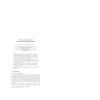Free Online Productivity Tools
i2Speak
i2Symbol
i2OCR
iTex2Img
iWeb2Print
iWeb2Shot
i2Type
iPdf2Split
iPdf2Merge
i2Bopomofo
i2Arabic
i2Style
i2Image
i2PDF
iLatex2Rtf
Sci2ools
EUROCRYPT
1999
Springer
1999
Springer
A Note on the Limits of Collusion-Resistant Watermarks
In one proposed use of digital watermarks, the owner of a document D sells slightly different documents, D1 , D2 , . . . to each buyer; if a buyer posts his/her document Di to the web, the owner can identify the source of the leak. More general attacks are however possible in which k buyers create some composite document D∗ ; the goal of the owner is to identify at least one of the conspirators. We show, for a reasonable model of digital watermarks, fundamental limits on their efficacy against collusive attacks. In particular, if the effective document length is n, then at most O( pn/ ln n) adversaries can defeat any watermarking scheme. Our attack is, in the theoretical model, oblivious to the watermarking scheme being used; in practice, it uses very little information about the watermarking scheme. Thus, using a proprietary system seems to give only a very weak defense.
| Added | 04 Aug 2010 |
| Updated | 04 Aug 2010 |
| Type | Conference |
| Year | 1999 |
| Where | EUROCRYPT |
| Authors | Funda Ergün, Joe Kilian, Ravi Kumar |
Comments (0)

